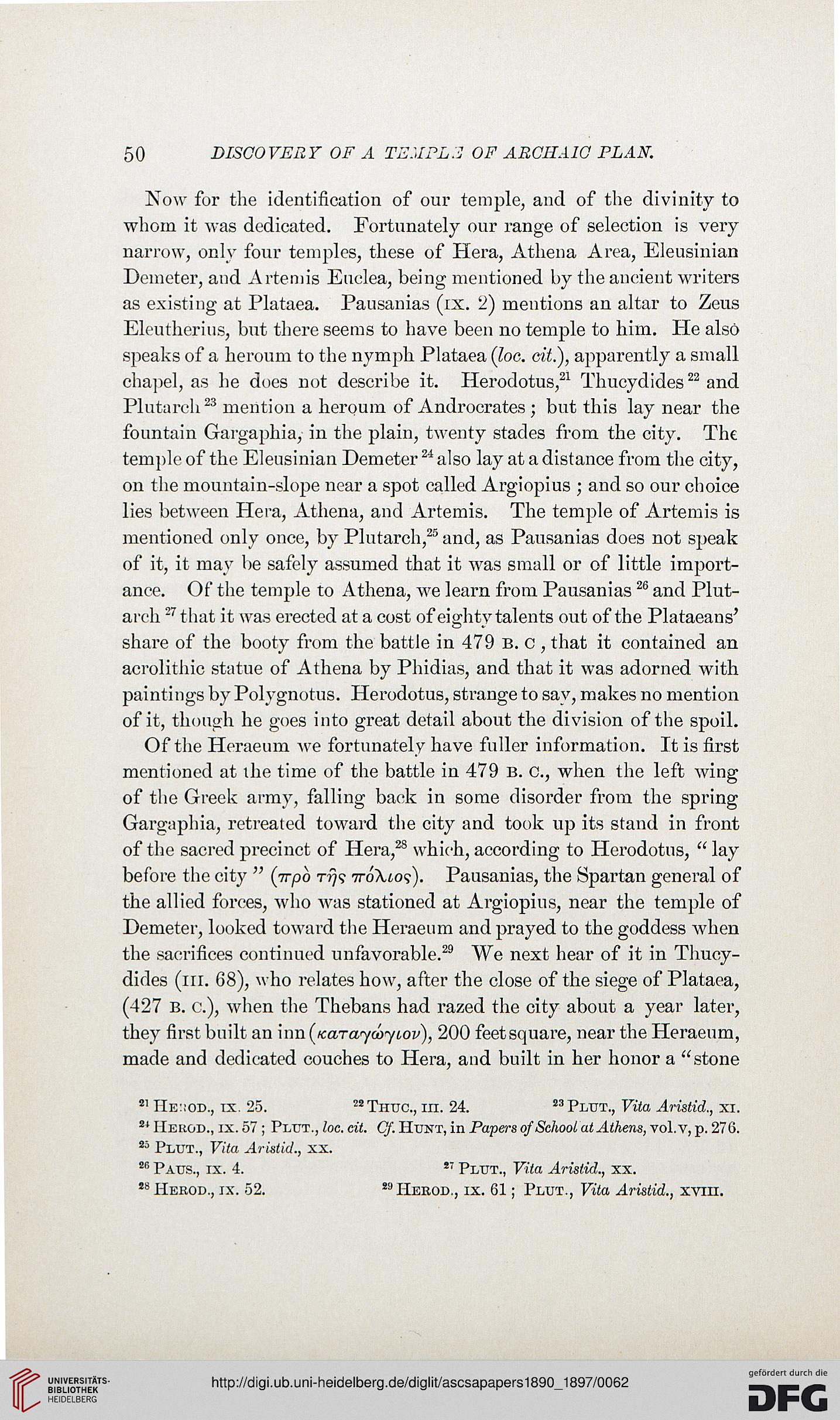50
DISCOVERY OF A TEMPL3 OF ABCHA10 PLAN.
Now for the identification of our temple, and of the divinity to
whom it was dedicated. Fortunately our range of selection is very
narrow, only four temples, these of Hera, Athena Area, Eleusinian
Demeter, and Artemis Euclea, being mentioned by the ancient writers
as existing at Plataea. Pausanias (ix. 2) mentions an altar to Zeus
Elcutherius, but there seems to have been no temple to him. He also
speaks of a heroum to the nymph Plataea (loo. cit.), apparently a small
chapel, as he does not describe it. Herodotus,21 Thucydides22 and
Plutarch23 mention a heroum of Androcrates ; but this lay near the
fountain Gargaphia, in the plain, twenty stades from the city. The
tempie of the Eleusinian Demeter24 also lay at a distance from the city,
on the mountain-slope near a spot called Argiopius ; and so our choice
lies between Hera, Athena, and Artemis. The temple of Artemis is
mentioned only once, by Plutarch,25 and, as Pausanias does not speak
of it, it may be safely assumed that it was small or of little import-
ance. Of the temple to Athena, we learn from Pausanias 26 and Plut-
arch 27 that it was erected at a cost of eighty talents out of the Plataeans'
share of the booty from the battle in 479 B. c , that it contained an
acrolithic statue of Athena by Phidias, and that it was adorned with
paintings by Polygnotus. Herodotus, strange to say, makes no mention
of it, though he goes into great detail about the division of the spoil.
Of the Heraeum we fortunately have fuller information. It is first
mentioned at the time of the battle in 479 B. c, when the left wing
of the Greek army, falling back in some disorder from the spring
Gargaphia, retreated toward the city and took up its stand in front
of the sacred precinct of Hera,28 which, according to Herodotus, " lay
before the city " (jn-pb rr}<; 7ro\to?). Pausanias, the Spartan general of
the allied forces, who was stationed at Argiopius, near the temple of
Demeter, looked toward the Heraeum and prayed to the goddess when
the sacrifices continued unfavorable.29 We next hear of it in Thucy-
dides (in. 68), who relates how, after the close of the siege of Plataea,
(427 B. a), when the Thebans had razed the city about a year later,
they first built an 'um(icaTayd)yLov), 200 feet square, near the Heraeum,
made and dedicated couches to Hera, and built in her honor a "stone
21 IIe::od., tx. 25. 22Thtjc, in. 24. 23 Pltjt., Vita Aristid., xi.
s* Herod., ix. 57 ; Pltjt., loc. cit. Cf. Hunt, in Papers of School at Athens, vol.v, p. 270.
25 Pltjt., Vita Aristid., xx.
26 Paus., ix. 4. 27 Pltjt., Vita Aristid., xx.
28 Herod., ix. 52. 20 Herod., ix. 61; Pltjt., Vita Aristid., xvih.
DISCOVERY OF A TEMPL3 OF ABCHA10 PLAN.
Now for the identification of our temple, and of the divinity to
whom it was dedicated. Fortunately our range of selection is very
narrow, only four temples, these of Hera, Athena Area, Eleusinian
Demeter, and Artemis Euclea, being mentioned by the ancient writers
as existing at Plataea. Pausanias (ix. 2) mentions an altar to Zeus
Elcutherius, but there seems to have been no temple to him. He also
speaks of a heroum to the nymph Plataea (loo. cit.), apparently a small
chapel, as he does not describe it. Herodotus,21 Thucydides22 and
Plutarch23 mention a heroum of Androcrates ; but this lay near the
fountain Gargaphia, in the plain, twenty stades from the city. The
tempie of the Eleusinian Demeter24 also lay at a distance from the city,
on the mountain-slope near a spot called Argiopius ; and so our choice
lies between Hera, Athena, and Artemis. The temple of Artemis is
mentioned only once, by Plutarch,25 and, as Pausanias does not speak
of it, it may be safely assumed that it was small or of little import-
ance. Of the temple to Athena, we learn from Pausanias 26 and Plut-
arch 27 that it was erected at a cost of eighty talents out of the Plataeans'
share of the booty from the battle in 479 B. c , that it contained an
acrolithic statue of Athena by Phidias, and that it was adorned with
paintings by Polygnotus. Herodotus, strange to say, makes no mention
of it, though he goes into great detail about the division of the spoil.
Of the Heraeum we fortunately have fuller information. It is first
mentioned at the time of the battle in 479 B. c, when the left wing
of the Greek army, falling back in some disorder from the spring
Gargaphia, retreated toward the city and took up its stand in front
of the sacred precinct of Hera,28 which, according to Herodotus, " lay
before the city " (jn-pb rr}<; 7ro\to?). Pausanias, the Spartan general of
the allied forces, who was stationed at Argiopius, near the temple of
Demeter, looked toward the Heraeum and prayed to the goddess when
the sacrifices continued unfavorable.29 We next hear of it in Thucy-
dides (in. 68), who relates how, after the close of the siege of Plataea,
(427 B. a), when the Thebans had razed the city about a year later,
they first built an 'um(icaTayd)yLov), 200 feet square, near the Heraeum,
made and dedicated couches to Hera, and built in her honor a "stone
21 IIe::od., tx. 25. 22Thtjc, in. 24. 23 Pltjt., Vita Aristid., xi.
s* Herod., ix. 57 ; Pltjt., loc. cit. Cf. Hunt, in Papers of School at Athens, vol.v, p. 270.
25 Pltjt., Vita Aristid., xx.
26 Paus., ix. 4. 27 Pltjt., Vita Aristid., xx.
28 Herod., ix. 52. 20 Herod., ix. 61; Pltjt., Vita Aristid., xvih.




